Metal processing online planning "Advanced stamping sheet metal process and equipment" theme forum, invites the know-how of the latest technology in digital industry, from the latest developments and applications of stamping sheet metal technology, equipment, technology, etc., showing the status quo of stamping sheet metal industry And development trends.

Liu Zhiyong, Sales Manager, Stamping Automation Department, Shanghai ABB Engineering Co., Ltd.
At present, the stamping workshop faces many challenges. Can it have excellent press equipment and fast and stable automatic transfer system? Does the above equipment invested heavily in the purchase bring the expected output? the answer is negative. According to the analysis, the following problems occur in each press shop: 1 Due to the quality problems of the mold and the sheet, the press is usually reduced in running speed. 2 Clutches, brakes, etc. have a large maintenance workload and high cost. 3 The production line consumes too much energy and the operating costs increase. 4 The press and the conveyor system wait for each other to cause the efficiency to be too low. 5 The production line speed is too slow to achieve the expected performance.
The reason for the analysis is: 1 The speed of the press flywheel determines the speed of the press, which determines the cycle of the press, which means that if the flywheel speed is increased, the speed of the deep drawing parts is also increased. 2 The speed of the press cannot be dynamically adjusted to synchronize with automation to reduce the time waiting for each other. 3 The utilization of energy is very low. Since the brake of the press stops at the top dead center TDC in each cycle, the clutch and brake need to be cooled to consume a large amount of energy. 4 Clutches and brakes need to be maintained frequently to reduce downtime.
So why do you have to be subject to these restrictions? Liu Zhiyong, Sales Manager of Stamping Automation Department of Shanghai ABB Engineering Co., Ltd. told the metal processing online reporter that a simple servo press can solve the problem, but it solves the old problem and brings new problems, such as the need for large size, expensive motor and Controller; requires large peak power, which means that the grid needs to be updated; the original press cannot be modified. ABB proposes a new solution, the servo press control technology (DDC) between the servo direct drive and the mechanical press.
The DDC is upgraded with all the original mechanical press components remaining unchanged. The action is: 1 press at top dead center TDC: the clutch is disengaged (but the flywheel is still rotating) and the servo motor begins to accelerate the slider. 2 The servo motor guides the slider down at high speed and then starts to decelerate to the punching speed as it approaches the punching point. 3 Before the punching point, the clutch is sucked, and the main shaft and the flywheel run synchronously. 4 flywheels provide punching energy. 5 At bottom dead center BDC: The clutch is disengaged and the servo motor begins to accelerate and pull up the slider in reverse. 6 When approaching the top dead center TDC, the servo motor is synchronized with the loading robot, and the loading and unloading is completed and the next cycle is entered.
The benefits of upgrading to DDC are: 1 It is visible from the position-time curve, shortening the blank time, and increasing the production tempo at the same drawing speed and drawing time. 2 The existing presses use the original ordinary molds. The transformation of the existing presses is limited to the top cover, which can be easily upgraded to DDC servo presses, and the investment is reduced. 3 The product obtained under the same stamping tempo has better quality, longer material flow time and lower cutting speed, which can balance the tempo or improve the quality. The 4DDC clutch is synchronized with the flywheel, minimizes clutch friction and minimizes torque shock, and the life of the clutch and brake is extended. And the system energy loss is reduced by more than 20%, and the electric energy generated during braking can be fed back to the grid. Compared with traditional servo presses, 5DDC has lower peak power (DDC only needs 10% peak power of traditional servo press, no need to modify the grid), and can provide full punching force at any speed, in servo mode and mechanical mode. Switch between buttons.
Taizhou Fengye Metal Products Co., Ltd. , https://www.fyhandware.com